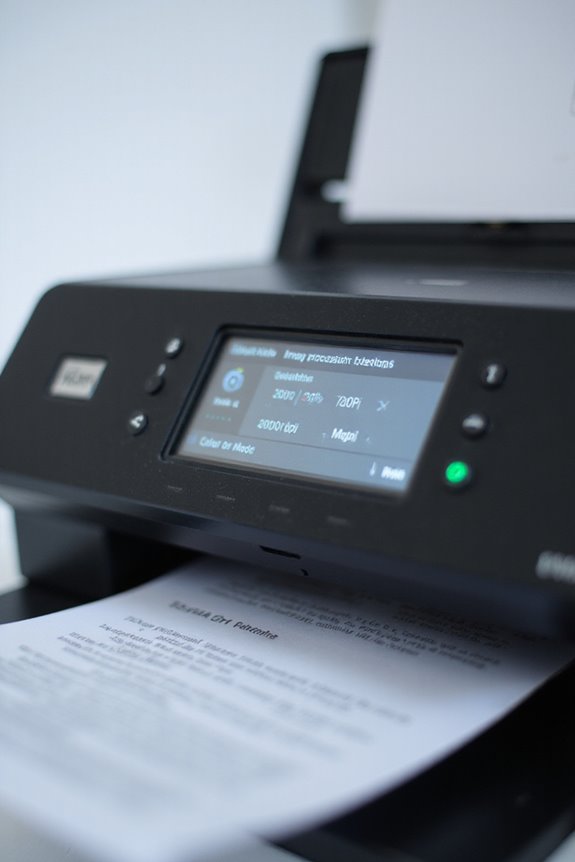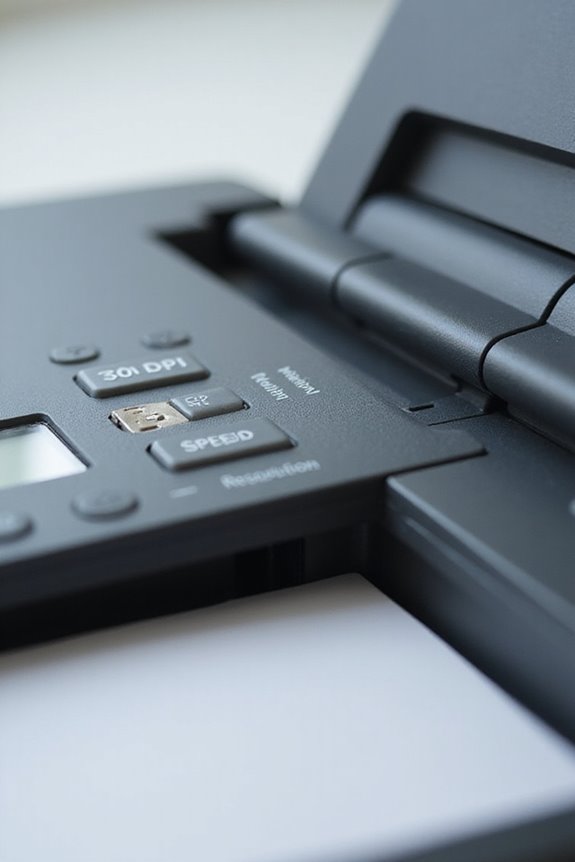To optimize our scanner settings for speed, we should start by selecting a resolution of 300 dpi for most documents, balancing clarity and speed. We can also speed up scanning by using black and white settings instead of color. Next, leveraging features like automatic cropping and noise reduction enhances efficiency. Additionally, utilizing batch scanning techniques and scheduling tasks during off-peak times can further streamline our workflow. By making these adjustments, we can greatly improve scanning speed and efficiency. More tips await!
Key Takeaways
- Set the scanner resolution to 300 dpi for a good balance of speed and clarity without sacrificing quality.
- Use black and white settings for faster scans compared to color options, when possible.
- Enable automatic document feeders (ADF) and duplex scanning to streamline the scanning process and minimize handling time.
- Adjust software configurations by enabling batch mode to process multiple documents efficiently at once.
- Regularly maintain and update scanner hardware and drivers to ensure optimal speed and performance.
Selecting the Right Resolution and Color Depth
When we choose the right resolution and color depth for scanning, we enhance our document’s quality without wasting time or storage. For most documents, a resolution selection of 300 dpi strikes a perfect balance between clarity and speed. Higher resolutions, like 600 dpi, boost quality but slow down the process. When scanning text documents, black and white scans are faster than color ones, allowing us to save time. Additionally, color depth is vital; a higher bit depth captures more colors, which is essential for photographs. However, it requires more storage. Remember, tailoring our resolution and color depth based on document type guarantees that we achieve the best quality while maintaining efficiency in our scanning workflow. Moreover, selecting the appropriate optical resolution can significantly impact the overall efficiency of your scanning tasks.
Utilizing Image Processing Features

Optimizing scanner settings involves more than just choosing the right resolution; it also includes utilizing advanced image processing features that can greatly enhance our document output. By leveraging noise reduction, we can considerably improve image clarity, guaranteeing our scanned documents are professional and clean. Features like automatic cropping help us refine our scans by focusing only on the essential content, while contrast enhancement boosts text readability. Additionally, document alignment through deskewing assures accuracy, making optical character recognition (OCR) more effective. Integrating metadata extraction allows for efficient organization, enabling quicker retrieval and management of files. These features work together, streamlining the entire scanning process and saving us time, ultimately improving our productivity. Furthermore, utilizing intelligent features like auto color and paper size detection can optimize scanning processes, ensuring efficient handling of diverse document formats.
Leveraging Hardware Capabilities

Leveraging hardware capabilities can greatly enhance our scanning experience, guaranteeing efficiency and quality. When selecting a scanner, we should prioritize hardware upgrades that improve speed and reliability. For instance, choosing models with automatic document feeders (ADF) minimizes manual handling, while duplex scanning cuts our workload in half by capturing both sides simultaneously. Regular scanner maintenance is also vital; cleaning the glass and replacing worn feed rollers guarantees smooth operation. Additionally, keeping firmware updated maximizes compatibility with our software and can boost speed. By investing in high-quality optical sensors and utilizing hardware acceleration features, we can enhance image fidelity and processing speed, ultimately improving our overall workflow. Staying proactive about these factors will guarantee our scanning processes remain swift and effective. Moreover, selecting a scanner with a high scanning speed of up to 35 pages per minute can significantly reduce the time spent on large volume tasks.
Implementing Batch Scanning Techniques

Implementing batch scanning techniques can transform our document handling processes, allowing us to efficiently digitize large volumes of paperwork in one go. With proper batch preparation, we can eliminate common delays by organizing documents beforehand—removing staples and ensuring consistent sizes. This minimizes interruptions that slow our workflow. Features like double-feed detection and automated error handling help maintain smooth scans by quickly addressing any issues, allowing us to focus on the big picture. Additionally, integrating Optical Character Recognition (OCR) converts our scanned documents into searchable, editable text, which enhances data accessibility. By automating repetitive tasks, batch scanning cuts down processing time, making it especially invaluable for archives, legal offices, and large enterprises. Utilizing scanners with advanced capabilities can further streamline the process and improve overall efficiency.
Optimizing Driver and Software Configuration

As we streamline our document processes through batch scanning, the next important step involves fine-tuning our driver and software configurations. First, we should focus on driver selection—ensuring we’re using the correct TWAIN driver tailored to our scanner. Regular software updates are essential too, keeping everything compatible and running smoothly. Lowering scanning resolution and color depth can greatly enhance speed, without excessively impacting quality. We’ll also benefit from optimizing software settings, like enabling batch mode to boost efficiency. By managing resources effectively and confirming system compatibility, we’re setting ourselves up for seamless performance. With the right configurations in place, we can maximize our scanning speed, making our document management processes faster and more effective. Additionally, it’s important to consider maintenance for optimal performance to ensure that your scanner operates at its best.
Enhancing Network and Data Transfer Speed
When we look to enhance network and data transfer speeds for our scanners, several key strategies can make a significant difference. First, we should focus on network optimization, ensuring that our settings, like packet size and bandwidth allocation, are tailored for increased efficiency. Reducing latency through optimized routing or Quality of Service (QoS) settings can lead to noticeable improvements in data transfer speeds. Additionally, implementing data compression techniques will minimize the amount of data sent over our networks, speeding up overall transmission. Finally, utilizing parallel data streams allows for faster processing, especially when dealing with intense scanning jobs. By adopting these strategies, we can maximize our scanner’s performance and efficiency in any environment. Furthermore, ensuring high-capacity batteries can support longer scanning sessions without interruptions is essential for maintaining optimal performance.
Automating Workflow With Scanning Software
Automating workflows with scanning software can revolutionize how we handle documents, transforming tedious processes into streamlined operations. By implementing automated indexing, we can efficiently organize scanned documents using metadata, making retrieval quicker and markedly reducing time spent searching. In fact, automation can cut repetitive tasks by up to 95%, allowing us to focus on more meaningful work. Workflow integration with document management systems guarantees that scanned files flow seamlessly into our digital environment, avoiding delays caused by manual filing. With predefined templates and rules, we can standardize scanner settings and improve consistency. These enhancements not only speed up our processes but can also save companies thousands, if not millions, annually, depending on workflow complexity.
Managing Document Types for Efficient Scanning
To effectively manage document types for efficient scanning, we must first understand the distinctions between structured, semi-structured, and unstructured documents. Structured documents, like financial reports, have standard formats, enabling faster processing with optimized settings. Semi-structured documents, such as purchase orders, contain key-value pairs, which also support efficient scanning. Unstructured documents, like emails, may require more effort to process due to their varied formats. By identifying these document types, we can tailor our scanning settings accordingly, ensuring high-resolution for detailed formats and sufficient resolutions for simpler texts. This targeted approach enhances scanning efficiency, reduces errors, and improves overall workflow. Ultimately, effectively managing document types translates to faster processing and better quality output in our scanning operations.
Using Compression for Faster File Handling
Using compression can greatly enhance our document handling processes. By reducing file sizes through efficient compression algorithms, we can transmit documents faster and save valuable storage space. Even better, smaller files allow us to implement file encryption, enhancing data security while ensuring compliance with email attachment limits. Techniques like Optical Character Recognition (OCR) can cut file sizes by 50-90%, making documents more accessible and easier to share. Additionally, Mixed Raster Content (MRC) can reduce sizes up to 8-10 times without sacrificing quality. Tools like Adobe Acrobat Pro and ABBYY FineReader provide powerful features for these processes. By optimizing our scanner settings with these compression options, we can streamline our workflows and improve overall efficiency.
Scheduling Scanning Tasks for Peak Efficiency
Optimizing our scanner settings for compression is a great start, but we can’t overlook the importance of scheduling scanning tasks effectively. By implementing off-peak scheduling, we can considerably reduce queue buildup during high-demand times. For instance, limiting scans to 500 per hour helps prevent system overload and maintains efficiency. We should also avoid scheduling overlapping scans, as this can extend wait times. Monitoring our scan queue management allows us to identify the best times for processing, such as early mornings or late nights. Preparing documents beforehand, like removing staples, keeps workflows smooth. By prioritizing critical tasks and leveraging automation tools, we enhance our productivity and make the best use of available resources. Let’s make scanning more efficient!
Frequently Asked Questions
How Can I Determine the Ideal Scanning Settings for My Documents?
When we think about determining perfect scanning settings, aren’t document types and resolution settings essential? By evaluating these factors, we can create ideal scans that cater to our specific needs, ensuring quality and efficiency.
What Type of Scanner Is Best for High-Volume Scanning Tasks?
When we think about high-volume scanning tasks, sheet-fed scanners generally outperform flatbed scanners due to their speed and efficiency. Let’s focus on sheet-fed options for peak performance in large-scale document processing needs.
How Do Different File Formats Impact Scanning Speed and Quality?
Ever wondered how file format efficiency affects our scanning process? We must balance image quality trade-offs; JPEG provides speed, while TIFF offers superior quality. Choosing wisely impacts both our workflow and final outputs considerably.
Can I Integrate My Scanner With Existing Document Management Software?
We can integrate our scanner with existing document management software by ensuring scanner compatibility and utilizing software integration features. This will streamline our workflow, enhance productivity, and improve document handling efficiency across our systems.
What Maintenance Tips Improve Scanner Performance and Longevity?
To improve our scanner’s performance and longevity, we should prioritize regular cleaning and software updates. Staying proactive with these maintenance tasks keeps our device running smoothly, minimizing downtime and enhancing our overall scanning experience.





